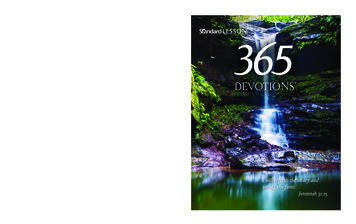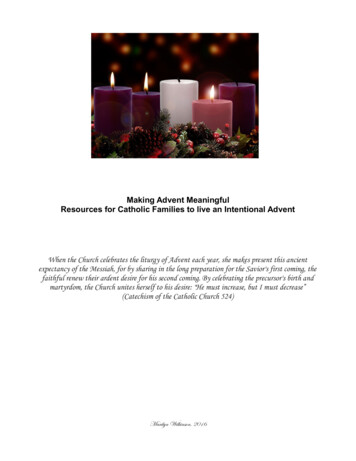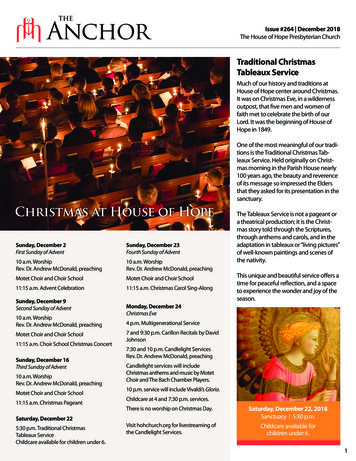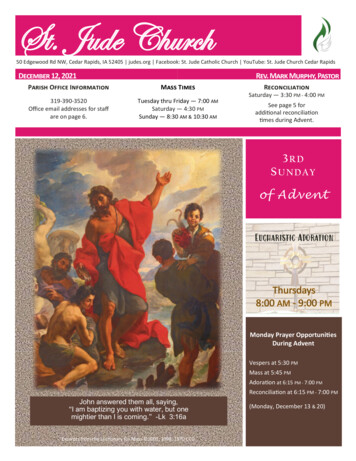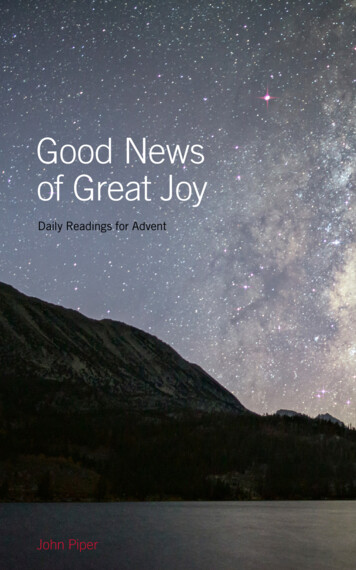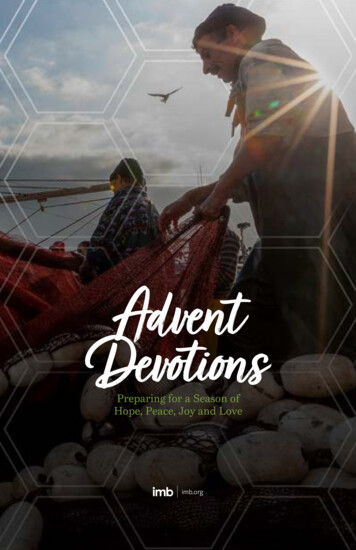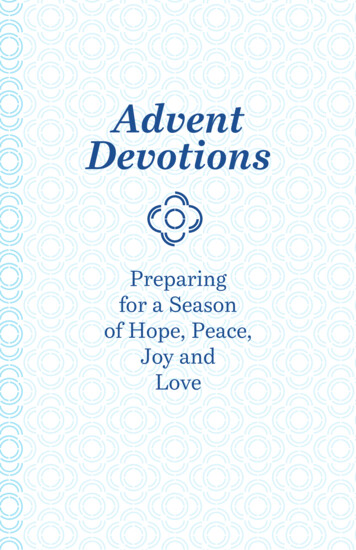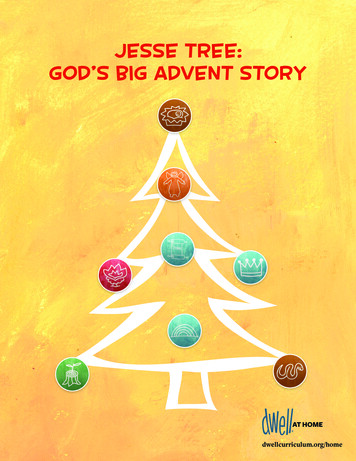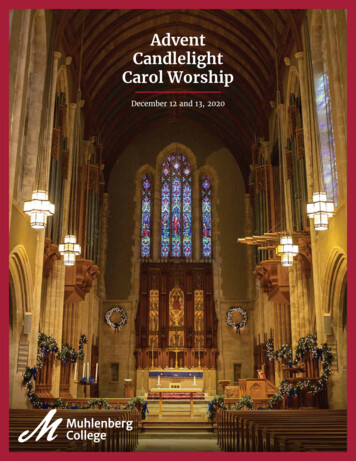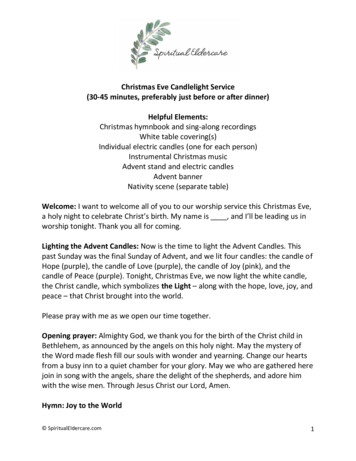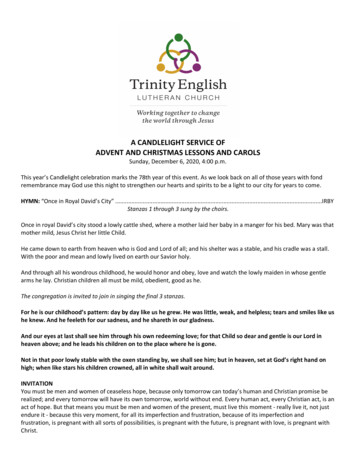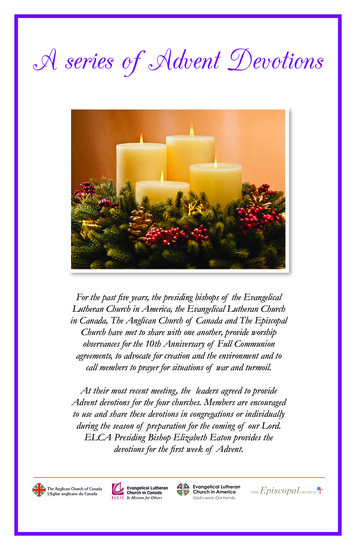
Transcription
A series of Advent DevotionsFor the past five years, the presiding bishops of the EvangelicalLutheran Church in America, the Evangelical Lutheran Churchin Canada, The Anglican Church of Canada and The EpiscopalChurch have met to share with one another, provide worshipobservances for the 10th Anniversary of Full Communionagreements, to advocate for creation and the environment and tocall members to prayer for situations of war and turmoil.At their most recent meeting, the leaders agreed to provideAdvent devotions for the four churches. Members are encouragedto use and share these devotions in congregations or individuallyduring the season of preparation for the coming of our Lord.ELCA Presiding Bishop Elizabeth Eaton provides thedevotions for the first week of Advent.
Advent 1Isaiah 64:1-91 Corinthians 1:3-9Mark 13:24-37God beyond time, help us to live in the tensionbetween what you have done andwhat you will do, and into the truththat Christ will come again.Amen.
by Elizabeth EatonTHE BURPEE SEED CATALOGUE is the epitomeof beauty, grace and proportion. Its pages display thePlatonic ideal of which my garden is a poor reflection.Leafing through the catalog I have been beguiled by imagesof perfect vegetables and beautiful flowers.I remember my first encounter, my first brush with theexcitement and danger of the Burpee’s catalog, a phone and acredit card. It was the page with the fields of lavender. I couldturn our Columbus, Ohio house into Provence! But the factthat our lot was small enough to mow the lawn with a weedwhacker brought me back from the abyss. I decided to ordertulip bulbs instead.Tulip bulbs must be planted in the fall. (They also mustbe planted right side up I discovered, but that is anotherstory.) We all know how autumn is in the parish: the start-upof Sunday School, choir rehearsals and committee meetings. Ididn’t plant in September or October.Finally, toward the end of November, I took my tulipbulbs, bone meal and trowel and set out to transform thebackyard. Soil in Ohio is often clay. It was cold. It was raining.It was muddy. My husband would look out the back windowand shake his head. After a while even the dog left me. By thetime I had finished it was dark and the backyard was a soupy,lumpy, clay-ey mess. But all I could see were rows of brilliantred tulips warmed in the spring sun.Advent is an odd season. It isn’t culturally accessible. Itdoesn’t lend itself to retail. There are no made-for-TV moviestelling heartwarming stories about the great and terrible dayof the Lord. It is an unsettled season that holds in tensionthe now and the not yet, longing and hope, judgment andredemption. This is clear in the readings for the First Sundayin Advent.
In Isaiah, the people of Israel are languishing in Babylon.The nation had been defeated, the Temple destroyed,Jerusalem sacked and the people forced into exile. Israel hadexperienced the liberating power of God in the Exodus.Israel was waiting to be set free from exile in Babylon by Godwith that same power. The people are pleading with God, “Othat you would tear open the heavens and come down so thatthe mountains would quake at your presence” (Isaiah 64:1).They were caught between the first Exodus and waiting forthe second exodus, this time out of Babylon.In Mark, Jesus tells his disciples that the Son of Man willcome in clouds with great power and glory. “Then he willsend out the angels, and gather his elect from the four winds,from the ends of the earth to the ends of heaven” (Mark13:27). But Jesus does not give a timeline. To his disciples, tothe early church, to us, Jesus is not talking so much about hereas about near.We have celebrated the first Christmas. We know that thebabe in the manger grew to adulthood, inaugurated the newage of the reign of God and was crucified. We are on theother side of the first Easter, the resurrection, the triumphover sin and death. We confess, “Christ has died. Christ isrisen.” But we find ourselves in the muddy, lumpy mess of afallen world.Scripture tells us that “God saw everything that God hadmade, and indeed, it was very good” (Genesis 1:31). We haveheard Jesus’ promise from the cross to the criminal: “Truly Itell you, today you will be with me in Paradise” (Luke 23:43).And yet we live in a world still marred by sin. What a terribletension: we stand between two Edens, the one at the dawn ofcreation and the one at the close of the age.Now we can see the beautiful logic of Advent. Wherethe culture (and my heart, too, if I am honest) celebrates andholds on to the manger and the star, the shepherds and wise
men, to Mary and Joseph and the Christ child, the churchcalls us to look for the return of the King. Advent deepensthe tension between what the world was created to be andwhat it now is, between what God has done and what Godwill do.To our muddy, soupy, lumpy mess — when we walkedin darkness — God sent God’s midnight Son. Because ofEmmanuel, God with us, we can stand in our clay and seeglory. Advent is the season when we can say, “Christ has died.Christ is risen. Christ will come again.”In the meantime, we plant tulips and wait for spring.Elizabeth Eatonis the Presiding Bishop of theEvangelical Lutheran Church in America.A series of Advent devotions prepared by the leaders ofAnglican and Lutheran churches in full communionThe Anglican Church of CanadaL’Eglise anglicane du CanadaEvangelical LutheranChurch in CanadaIn Mission for Others
Advent 2Isaiah 40:1-112 Peter 3:8-15aMark 1:1-8God of holy patience, help us to offer a compassionate witnessagainst the fear and despair of our time.Amen.
by Katharine Jefferts SchoriThe world seems like a miserable and tragic mess thisyear — there is war all over the Middle East andstrife in Eastern Europe; western nations are increasinglydivided between abject poverty and obscene wealth; Ebolais spreading; our globe is warming, seas rising, and speciesdisappearing. Woe, woe, woe, everywhere we turn.In the face of that sort of invitation to despair, Isaiahcries, “Be of good cheer. Even though you know the perfidyof humankind, God is working his ancient promises out. Thepath to the Reign of God is emerging even now, even in themidst of dark despair.” (Isaiah’s use of “comfort” implies “bestrong.”)Peter tells a similarly despairing community to be patientand to be at peace. Whence cometh patience? Whencecometh my help? Patience is above all the ability to abide,even when it hurts like hell, knowing that God’s road keepsrolling out ahead of us, leading onward to healing, wholeness,and the holy peace that passes all understanding.Patience comes from a root that means to suffer or endure.It can be painful to wait, especially if we are eager for thebirth of a child, anxious to have an onerous task completed,or a wound healed. The deeper origin of the word lies ina root that means to hurt, injure, blame, revile, or damage— the word fiend comes from the same root. In some deepsense, patience is the virtue needed in the face of the fiendishand whatever is hostile to life.As Peter puts it, we wait for a new heaven and a newearth, in spite of all the forces that stand in the way. We waitpatiently, confident that God is working his purposes out. Yetpatience does not mean total passivity. Perhaps surprisingly,passive originally meant that one was capable of suffering;today it often implies that one is unfeeling and unresponsive.
To live as Jesus did is to embrace the world’s suffering —in as full a way as possible — and yet to endure, knowingthat God is still in our midst, and in the heart of the pain.Patience in this season of waiting is not just about putting upwith delay, but having deep compassion for all who wait forjustice, healing, and peace. It is about solidarity, and sufferingwith (which is the literal meaning of compassion).John the Baptizer is announcing the presence ofcompassion in the flesh — and reminding his hearers thatGod’s road builder toward that future is coming. Not only willa fellow sufferer stand with you, but he will help unfold thatpath to a healed world. The pathway isn’t finished yet, but ifyou’ll turn around, you will see it and become part of it.In this season of patience, what suffering claims yourheart? What do you wait for, in solidarity with another? Willyou join in building that road through the wild and fearsomedarkness?Our capacity for patience can be expanded. The ability tosit or stand or rest quietly can be cultivated, and short arrowprayers can be helpful: “Let me rest in you, O God,” “Holdme in the palm of your hand,” “Let me be still and know thatyou are God.” Some find it helpful to practice giving thanksin each breath, remembering with Dame Julian that God isas close as our breath and as enfolding as our clothing. Theconfidence and deep awareness of God’s intimacy is thesource of patience, and it gives rise to courage and strengthto endure and act in solidarity with the suffering.In this season of Advent we wait expectantly not only forthe birth of a child but for the birth of a new and enlivenedbody of God’s creation. Expectant parents never knowexactly what is coming, and in many parts of the world themother justly lives in considerable fear for her own life andthat of her child. As with Elizabeth and Mary, solidarity canrelieve those fears, building a bridge of trust, knowing that
others have endured, and that we are never alone. We areseeing bridges like that being built in the midst of Ebolafears, as the bold and brave stand with the ill and dying. Thewhole body of God’s creation awaits the resurrected lifefor which all were made. Where will you build that road ofsolidarity through fear and despair?Katharine Jefferts Schoriis the Presiding Bishop of the Episcopal Church.A series of Advent devotions prepared by the leaders ofAnglican and Lutheran churches in full communionThe Anglican Church of CanadaL’Eglise anglicane du CanadaEvangelical LutheranChurch in CanadaIn Mission for Others
Advent 3Isaiah 61:1-4, 8-111 Thessalonians 5:16-24John 1:6-8, 19-28God of our present age, stir up in us a longing for justicewith compassion and prepare us for thein-breaking reign of your love and peace.Amen.
by Susan JohnsonIn the Gospel reading we hear John the Baptist say, “I amthe voice crying in the wilderness, make straight the way ofthe Lord.”The passage from Isaiah captures what that voice in thewilderness is crying for:to bring good news to the oppressed, to bind up thebrokenhearted, to proclaim liberty to the captives, andrelease to the prisoners; to proclaim the year of the Lord’sfavour, and the day of vengeance of our God; to comfortall who mourn.These words from Isaiah are what Jesus reads aloud in thesynagogue in Nazareth at the beginning of his ministry, goingon to announce, “Today this scripture has been fulfilled in yourhearing.”These readings underscore for me our need to offerprophetic voices crying in the wilderness — in the townsquares, in the halls of government, in the courts of law —on behalf of all those who are marginalized and oppressedand in need of justice.Is it just me, or do you also feel like the list of those inneed of justice keeps getting longer and longer?Our present age includes wars in Gaza, Ukraine,Syria, South Sudan, Nigeria, Central African Republic andelsewhere; the greatest number of refugees and internallydisplaced persons in the history of our planet; racialtensions made vivid by the death of Michael Brown andthe subsequent and sometimes violent demonstrations inFerguson, Missouri; the growing number of missing andmurdered indigenous women in Canada; hunger and povertyaround our world and in our own countries; homelessness;domestic violence; human trafficking; more.
The list is long.Yet we are called to be like John the Baptist, crying outand working for justice, following the example of Jesus. Wedo this as churches, individually and cooperatively.This past September, the leaders of the Anglican Churchof Canada, the Evangelical Lutheran Church in America, theEvangelical Lutheran Church in Canada and the EpiscopalChurch issued a joint pastoral letter on climate change. Thiswas an important national and international effort. But we arecalled to cry out and work for justice individually and in ourlocal context as well.We work for justice through our heartfelt prayers and ourofferings to support the work of the wider church. We workfor justice as we petition our elected leaders, letting themknow of our concerns. We work for justice as we volunteerin local ministries whether through our churches or throughsuch community agencies as food banks, out-of-the-coldprograms, homeless shelters and more. We work for justicewhen we take to the streets in silent vigil or loud, non-violentprotest.How is this true for you? How are you crying out for andworking for justice? What more could you, your congregation,your community, your church be doing?
Susan Johnsonis the National Bishop of the Evangelical Lutheran Church in Canada.Photo Michael Hudson for General Synod CommunicationsA series of Advent devotions prepared by the leaders ofAnglican and Lutheran churches in full communionThe Anglican Church of CanadaL’Eglise anglicane du CanadaEvangelical LutheranChurch in CanadaIn Mission for Others
Advent 42 Samuel 7:1-11, 16Romans 16:25-27Luke 1:26-38God of courage and fulfilment, help us to make Mary’s Songour song — the song of our lives and of our work;the song of the Church and its life and work in the world.Amen.
by Fred HiltzLike you, I am always glad to come to this fourth Sundayof Advent and its focus on Mary’s role in God’s planfor the redemption of the world. Mary is chosen by God tocarry the holy child in her womb. Mary is both favoured andtroubled by the angel’s message.Gabriel assures Mary that what is to be conceived in heris of the Holy Spirit. Called to be the very vessel thoroughwhom the word of God becomes flesh of our flesh, Marywill be known through every age as Theotokos — the one whobears God. Through Mary, God will inhabit the world in thelikeness of our human form, walk this earth and announcethe reign of divine reconciliation, justice and peace for allpeople.Of this moment of annunciation, much has been offeredby way of commentary through the centuries.I am personally intrigued by how Marie Azzarello, a sisterof the Congrégation de Notre-Dame religious communityin Montreal, speaks of the moment in her book, Mary: TheFirst Disciple. She writes: “ in many analyses it is a momentof consent. She did consent but it is important to note thatshe freely gave her consent. Otherwise we see her only asa passive, docile, obedient woman rather than a strong andcourageous woman, prepared to live with the Holy Spiritworking in and through her life, one in whom the purposesof God are fulfilled not only for her own moment in time butindeed for all time”.Mary’s moment of annunciation is followed quickly byher visit to Elizabeth. As they greet one another, one’s wordbecomes known in time as the Hail Mary and the other asMary’s Song or the Magnificat.Of Mary’s Song “it would be taken,” writes Herbert
O’Driscoll in Portrait of a Woman,“from her lips and beaugmented into a mighty anthem echoing in basilica andcathedral. In the centuries long monastic round of dailyoffices it would be the song that welcomes the approachof evening, the center point around which a jewel calledEnglish evensong would revolved. Yet it would also be a darkand terrible song of revolution quoted in societies movingthrough political turmoil, or continents seething with a desirefor change.”Truly it is the song of so many in our day.Of Mary’s Song, Azzarello writes, “to pray the Magnificateach day as a disciple of Jesus is to pray in union with Maryin joy, faith, and thanksgiving to God as the source of ourbeing; it is to sing of God’s everlasting love and mercy whichextends from age to age and to proclaim Mary’s hope in thefulfilment of the divine promises in favour of the whole ofhumanity. To pray the Magnificat is an expression of ourdesire to be honest about the state of our world and showsour conviction that the kingdom of God that Jesus preachedis not a vision for an end time but a vision that begins now, inthis world ”This is strong commentary and it is a challenge to live thegospel of which we sing.It leaves me pondering to what extent Mary’s Song is trulymy song; the song of my life and my work; the song of theChurch and its life and work in the world.
Fred Hiltzis the Primate of the Anglican Church of Canada.Photo Michael Hudson for General Synod CommunicationsA series of Advent devotions prepared by the leaders ofAnglican and Lutheran churches in full communionThe Anglican Church of CanadaL’Eglise anglicane du CanadaEvangelical LutheranChurch in CanadaIn Mission for Others
Israel was waiting to be set free from exile in Babylon by God with that same power. The people are pleading with God, “O that you would tear open the heavens and come down so that the mountains would quake at your presence” (Isaiah 64:1). They were caught between the first Exodus and
